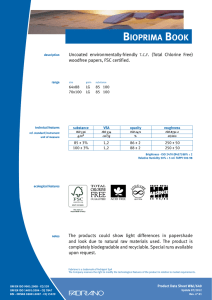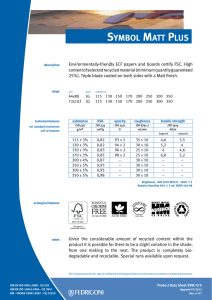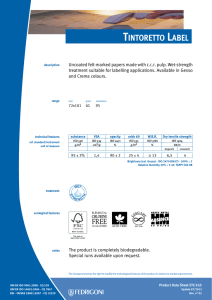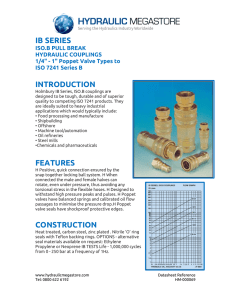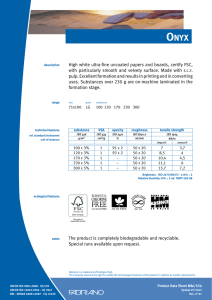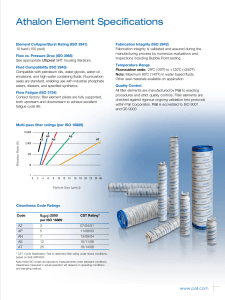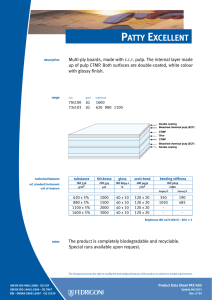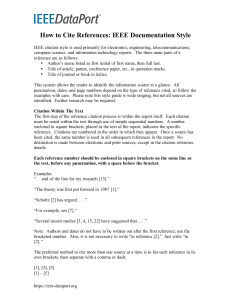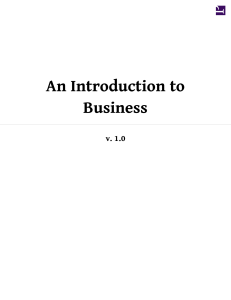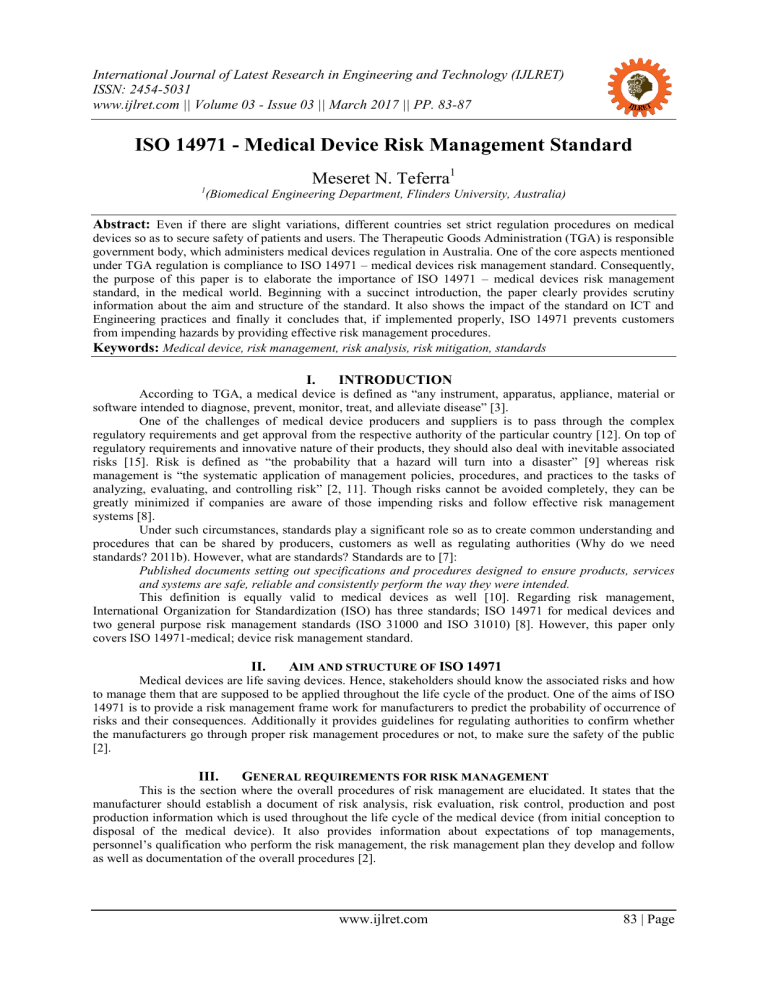
International Journal of Latest Research in Engineering and Technology (IJLRET) ISSN: 2454-5031 www.ijlret.com || Volume 03 - Issue 03 || March 2017 || PP. 83-87 ISO 14971 - Medical Device Risk Management Standard Meseret N. Teferra1 1 (Biomedical Engineering Department, Flinders University, Australia) Abstract: Even if there are slight variations, different countries set strict regulation procedures on medical devices so as to secure safety of patients and users. The Therapeutic Goods Administration (TGA) is responsible government body, which administers medical devices regulation in Australia. One of the core aspects mentioned under TGA regulation is compliance to ISO 14971 – medical devices risk management standard. Consequently, the purpose of this paper is to elaborate the importance of ISO 14971 – medical devices risk management standard, in the medical world. Beginning with a succinct introduction, the paper clearly provides scrutiny information about the aim and structure of the standard. It also shows the impact of the standard on ICT and Engineering practices and finally it concludes that, if implemented properly, ISO 14971 prevents customers from impending hazards by providing effective risk management procedures. Keywords: Medical device, risk management, risk analysis, risk mitigation, standards I. INTRODUCTION According to TGA, a medical device is defined as “any instrument, apparatus, appliance, material or software intended to diagnose, prevent, monitor, treat, and alleviate disease” [3]. One of the challenges of medical device producers and suppliers is to pass through the complex regulatory requirements and get approval from the respective authority of the particular country [12]. On top of regulatory requirements and innovative nature of their products, they should also deal with inevitable associated risks [15]. Risk is defined as “the probability that a hazard will turn into a disaster” [9] whereas risk management is “the systematic application of management policies, procedures, and practices to the tasks of analyzing, evaluating, and controlling risk” [2, 11]. Though risks cannot be avoided completely, they can be greatly minimized if companies are aware of those impending risks and follow effective risk management systems [8]. Under such circumstances, standards play a significant role so as to create common understanding and procedures that can be shared by producers, customers as well as regulating authorities (Why do we need standards? 2011b). However, what are standards? Standards are to [7]: Published documents setting out specifications and procedures designed to ensure products, services and systems are safe, reliable and consistently perform the way they were intended. This definition is equally valid to medical devices as well [10]. Regarding risk management, International Organization for Standardization (ISO) has three standards; ISO 14971 for medical devices and two general purpose risk management standards (ISO 31000 and ISO 31010) [8]. However, this paper only covers ISO 14971-medical; device risk management standard. IJLRET II. AIM AND STRUCTURE OF ISO 14971 Medical devices are life saving devices. Hence, stakeholders should know the associated risks and how to manage them that are supposed to be applied throughout the life cycle of the product. One of the aims of ISO 14971 is to provide a risk management frame work for manufacturers to predict the probability of occurrence of risks and their consequences. Additionally it provides guidelines for regulating authorities to confirm whether the manufacturers go through proper risk management procedures or not, to make sure the safety of the public [2]. III. GENERAL REQUIREMENTS FOR RISK MANAGEMENT This is the section where the overall procedures of risk management are elucidated. It states that the manufacturer should establish a document of risk analysis, risk evaluation, risk control, production and post production information which is used throughout the life cycle of the medical device (from initial conception to disposal of the medical device). It also provides information about expectations of top managements, personnel’s qualification who perform the risk management, the risk management plan they develop and follow as well as documentation of the overall procedures [2]. www.ijlret.com 83 | Page International Journal of Latest Research in Engineering and Technology (IJLRET) ISSN: 2454-5031 www.ijlret.com || Volume 03 - Issue 03 || March 2017 || PP. 83-87 IV. RISK ANALYSIS ISO 14971 defines risk analysis as “a systematic use of available information to identify hazards and to estimate the risk” (2007, p. 4). As per the definition, the standard provides a framework for the process of risk analysis. Medical devices manufacturers are expected to identify and analyze all possible risks to optimize efficiency and reduce incurred costs [2, 8]. IJLRET Figure 1: Risk Optimization vs. Quality and Cost [8]. On top of this, the producer should document the intended use, safety procedures and hazards of its medical devices [2]. a. ESTIMATING PROBABILITY (P) AND SEVERITY (S) Even if varied techniques are used, it is common to determine the probability or likelihood of occurrence of risks and if it happens how big, the risk is (severity). The inference can be in terms of qualitative, quantitative or semi-quantitative scales [8]. Figure 2: Graphical determination of risk [8]. www.ijlret.com 84 | Page International Journal of Latest Research in Engineering and Technology (IJLRET) ISSN: 2454-5031 www.ijlret.com || Volume 03 - Issue 03 || March 2017 || PP. 83-87 b. RISK PROBABILITY NUMBER Assigning values to the qualitative values; high (3), medium (2) and low (1) the overall risk can be determined from risk priority numbers (RPNs). RPNs are calculated from the severity and occurrence of risk using the following relation [8]. Figure 3: Graphical Determination of Risk including Detectability [8]. RPN = Severity (S) x Probability (P) ………………………………….. (1) V. RISK EVALUATION AND RISK CONTROL IJLRET According to ISO 14971 [2]: Risk evaluation is the process of comparing the estimated risk against given risk criteria to determine the acceptability of the risk. On the other hand controlling the risk involves decisions making and taking appropriate action to reduce or maintain the risk within the specified levels. Risks can be kept within the accepted limit by applying proper risk evaluation and control techniques, which can be documented for later use. The manufacturer is also expected to verify the effectiveness of implemented control mechanisms [2]. a. DETERMINING RISK THRESHOLD The first step in risk evaluation and control is determining risk threshold value (RT) that measures the amount of risk that the company can tolerate. These numbers should be communicated to all concerned parties of the company and to higher officials for decision-making [8]. b. RISK MITIGATION Risk mitigation is defined as “the process by which an organization introduces specific measures to minimize or eliminate unacceptable risks associated with its operations” [6]. Though risk mitigation is essential, it is not always the case; hence, it can be optional and may lead to unnecessary costs [1]. One of the best ways to implement cost-effective risk improvement procedures is by comparing the risk probability number with the predetermine risk criteria [8]. www.ijlret.com 85 | Page International Journal of Latest Research in Engineering and Technology (IJLRET) ISSN: 2454-5031 www.ijlret.com || Volume 03 - Issue 03 || March 2017 || PP. 83-87 Figure 4: Figure 4: Risk Priority Number vs. Risk Threshold [8]. According to figure 4 above, risk mitigation is necessary whenever the risk factor is higher than the risk threshold in order to keep the overall residual risk below the threshold value [2, 8]. c. RISK MANAGEMENT REPORT, PRODUCTION AND POSTPRODUCTION INFORMATION Review and filing of the risk management process is the end step before the medical device is commercialized. Additionally production or post production information about the same or similar medical device can be collected using files and documents prepared throughout the risk management process [2]. IJLRET VI. IMPACT OF THE ISO 14971 ON ICT AND ENGINEERING PRACTICES “A poor understanding of standards issues regarding engineering design, product development, marketing, and market acceptance has undesirable consequences” [14]. In this regard, ISO 14971 provides risk management framework for medical devices stakeholders, customers and regulating authorities [2]. Engineers as well as ICT professionals who work in medical device manufacturing company are expected to note this framework to reduce the manufacturing cost, minimize associated hazards and to get approval of marketing [2]. As integral part of a medical device, the ISO 14971 grants the mechanism to assess the risks and manage associated hazards of software [13]. VII. CONCLUSION Medical devices are used by humans and should be safe to use. However, risks cannot be avoided completely, they can be greatly minimized if companies are aware of those impending hazards and follow effective risk management systems. ISO 14971 is a risk management standard for medical devices that provides systematic framework of risk management policies, procedures and practices. The standard states that the manufacturer should establish a document of risk analysis, risk evaluation, risk control, production and post production information, which is used throughout the life cycle of the medical device. It also provides information about expectations of top managements, personnel’s qualification who perform the risk management, the risk management plan they develop and follow as well as documentation of the overall procedures. Engineers as well as ICT professionals who work in medical device manufacturing company are expected to note this framework to reduce the manufacturing cost, minimize associated hazards and to get approval of marketing by government authorities. To sum up, ISO 14971 prevents customers from impending hazards by providing effective risk management procedures. www.ijlret.com 86 | Page International Journal of Latest Research in Engineering and Technology (IJLRET) ISSN: 2454-5031 www.ijlret.com || Volume 03 - Issue 03 || March 2017 || PP. 83-87 REFERENCES [1]. [2]. [3]. [4]. [5]. [6]. [7]. [8]. [9]. [10]. [11]. [12]. [13]. [14]. [15]. 2004, What is Risk Mitigation? [Online]: Risk Mitigation Associates, Available: http://www.riskmitigationassoc.com/cgs.aspx?id=wirm1[Accessed August 31, 2012]. 2007, ISO 14971 [Online], International organization for standardization (ISO) Available:http://www.isosert.ru/isosert_iso_14971.pdf[Accessed August 8, 2012]. 2011a, Australian regulatory guidelines for medical devices (ARGMD) [Online], Available: http://www.tga.gov.au/pdf/devicesargmd.pdf[Accessed August 10, 2012]. 2011b, why do we need standards? [Online]: European Telecommunications Standards Institute - ETSI Available: http://www.etsi.org/WebSite/Standards/WhyWeNeedStandards.aspx [Accessed August 17, 2012]. 2012a, ISO 14971 Medical Devices [Online]: The British Standards Institution Available: http://www.bsigroup.ca/enca/assessmentandcertification/managementsystems/standardsschemes/iso14971/[Accessed August 24, 2012]. 2012b, Risk mitigation [Online]: WebFinance, Inc., Available: http://www.investorwords.com/19332/risk_mitigation.html[Accessed August 31, 2012]. 2012c, What is a Standard? [Online]: Standards Australia, Available:http://www.standards.org.au/StandardsDevelopment/What_is_a_Standard/Pages/default.aspx [Accessed August15, 2012]. n.d. -a, Risk Management in the (Bio) Pharmaceutical and Device Industry [Online]: Labcompliance Available:http://www.labcompliance.com/tutorial/risk/default.aspx[Accessed August17, 2012]. n.d. -b, What is Risk? [Online], Available: http://www.unisdr.org/2004/campaign/bookleteng/Pagina9ing.pdf Bandar F. Al-Mifgai n.d., Medical Device Standards [Online], Available:http://www.strategicstandards.com/files/MedicalDeviceStandards.pdf[Accessed August 08, 2012]. Begoña Narvaez & Hyman, William A. n.d., Prospective Risk Management:Analysis, Evaluation, and Control [Online], Available:http://www.psqh.com/septemberoctober-2010/633-prospectiveriskmanagement-.html[Accessed August8, 2012]. Sandra Brolin n.d., Global Regulatory Requirements for Medical Devices Mälardalen University Available:http://mdh.divaportal.org/smash/get/diva2:121327/FULLTEXT01[Accessed August 12,2012]. Peter Jordan n.d.,Medical Device Software Standards [Online]: The IEEE Available:http://ieeexplore.ieee.org.ezproxy.flinders.edu.au/ielx5/5674129/5679193/05679198.pdf?tp= &arnumber=5679198&isnumber=5679193[AccessedAugust 18, 2012]. Daniel Schultz 2005, Standards in Education [Online], Available:http://www.astm.org/SNEWS/JULY_2005/schultz_jul05.html[AccessedAugust 24, 2012]. Trend lines International and Donawa Consulting 2008, A Regulatory Primer [Online]: The Trendlines Group Ltd., Available:http://www.donawa.com/medicaldevice/donawa/files/A%20Regulatory%20Primer.pdf[Acce ssed July 24,2012]. IJLRET www.ijlret.com 87 | Page

